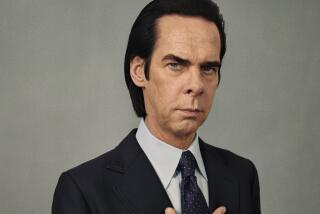Review: Tragedy hovers over the haunting Nick Cave documentary âOne More Time With Feelingâ
About 10 minutes into âOne More Time with Feeling,â when Nick Cave and the Bad Seeds begin playing the first of an albumâs worth of songs, a wave of sadness surges, bone-deep and breathtaking. The craftsmanship and beauty of the track, âJesus Alone,â is undeniable, but something else, something ineffable, is unfolding in the moment, as it will throughout this haunting film about creativity and loss.
The details of the loss that shattered Cave and his family are never spelled out in Andrew Dominikâs documentary. For those not aware that one of Caveâs sons, 15-year-old Arthur, died last year from injuries suffered in a fall from a cliff, it might seem that the movie teases out the heart of the matter at unnecessary length. But it becomes powerfully clear that the directorâs strategy echoes the instinctive response of Cave and his wife, Susie, to the unspeakable: The devastating, unchangeable truth is at the center of everything, affecting everything yet discrete, sealed off, beyond reason, explanation or understanding.
Dominik, whose feature âThe Assassination of Jesse James by the Coward Robert Fordâ was scored by Cave and his longtime collaborator Warren Ellis, moves between studio performances of the songs from âSkeleton Treeâ â the album that Cave and the band were recording at the time of Arthurâs death â and interviews with Cave. The filmmakerâs questions are sensitive yet penetrating, the musicianâs responses thoughtful, eloquent and pained. Caveâs voiceover commentary punctuates the onscreen proceedings, his musings forming an overlay of (dis)harmony, syncopated and questioning.
Itâs no surprise that Cave, a master of the dirge whose body of work has largely been concerned with âanxiety, dread and anguish,â as he himself sums it up, takes no comfort in platitudes. The word âgriefâ is spoken only once in the film as it circles the trauma that has led Cave â a novelist and screenwriter as well as a songwriter â to repudiate the idea of narrative, with its structure and wrap-up and morals. Life, he insists, is not a story. Rather than a beginning, middle and end, he sees, or wants to see, the simultaneity of past, present and future (an idea explored in the recently released âArrival,â which also involves the death of a child).
Using a specially built camera, Dominick and cinematographers Alwin W. KĂźchler and BenoĂŽt Debie have shot the documentary in the rare combination of 3D and black-and-white. The added dimension has the paradoxical effect of enhancing the sense of intimacy while inserting a level of distancing artifice. The aesthetic that Dominik has crafted is a pitch-perfect expression of Caveâs grappling with matters of time and space. Itâs gorgeous and ghostly.
In the reflective surface of a piano or the emptiness of a hotel room mirror, the shimmering monochromatic palette suggests the unseen and the barely glimpsed. The notion of something spectral behind moments fixed in memory is amplified in snapshots by Czech photographer Miroslav Tichy, an outsider artist whose work Cave admires.
âOne More Time with Feelingâ is as much about the creative process, including the making of the film itself, as it is about heartache. Dominik includes time-outs to recalibrate and focus the 3D image, and shows the bulky camera on a track circling Cave as he performs. Whether theyâre roving through and beyond the studio or gazing out in stillness from the mixing console, the cameras are attuned to the connections that remain, just as the Rasputin-bearded Ellis is constantly, lovingly alert to Caveâs mood.
Superstition and magical thinking inevitably arise â how could they not when youâre longing for the impossible, for the reversal of brutal fact? Susie, poignantly, is vexed by the black frame around a childhood drawing of Arthurâs. She welcomes the busyness of her work as a clothing designer, while her husband feels his creativity damaged. Yet âSkeleton Treeâ and the film about its making offer proof that his talent as one of rock ânâ rollâs premier symbolist poets is undiminished.
With this album, Cave says, he let go of his usual fastidiousness about lyrics, giving priority to a more improvisational energy. The songs document the collective emotional state of the musicians, all of whom knew Arthur. When Caveâs son Earl visits the studio, heâs all smiles and exuberance. Heâs also a boy who has lost his twin. The ghosts are everywhere in Dominikâs exquisitely tender film, and when Cave sings âWith my voice I am calling you,â he turns a simple line into a timeless lament.
===
âOne More Time with Feelingâ
Not rated
Running time: 1 hour, 52 minutes
Playing: Downtown Independent, Los Angeles; Laemmleâs Ahrya Fine Arts Theater, Beverly Hills; Laemmleâs Playhouse 7, Pasadena; Laemmleâs NoHo 7, North Hollywood; Laemmleâs Monica Film Center, Santa Monica; Landmark Regent, West Los Angeles; Art Theater, Long Beach; Laemmleâs Claremont 5, Claremont; Frida Cinema, Santa Ana
More to Read
Only good movies
Get the Indie Focus newsletter, Mark Olsen's weekly guide to the world of cinema.
You may occasionally receive promotional content from the Los Angeles Times.










